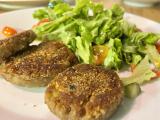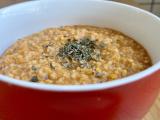Curry Lentil Balls with Salad
Table of Contents
Jump to Recipe
Jump to Carbon Footprint
Welcome to another little anniversary of “Climate-Friendly Cooking” - our thirtieth recipe. ✨ As with our twentieth recipe (Oven-baked Zucchini and Cheese Tater Tots), this is a little gift - a guest post from my mum. 🎁 Hi Mum! 👋
The curry lentil balls were a hit with the family on a warm summer evening on the patio. They are reminiscent of falafel, especially if you adjust the spices a bit and use coriander and cardamom instead of curry. The salad uses some of the same ingredients as the balls - unusual at first, but delicious.
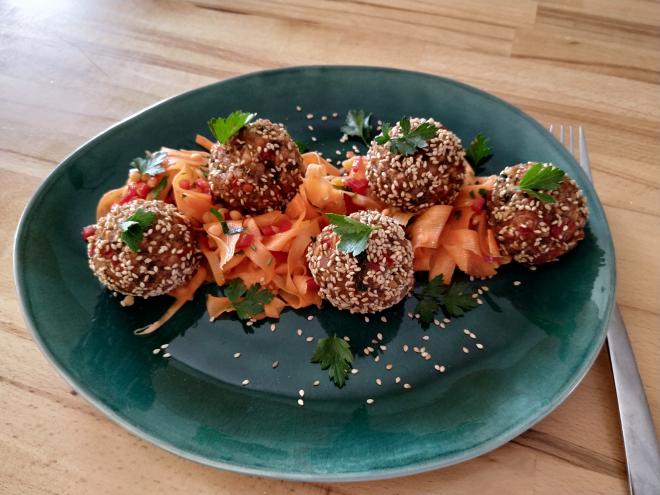
A little trick: if you have an ice-cream scoop, you can use it to make particularly attractive and evenly sized balls.
You can also vary the salad: For example, add a little nectarine for extra sweetness, spring onions for freshness and pungency, cucumber for a little more juiciness or walnuts or pine nuts for a little more crunch.
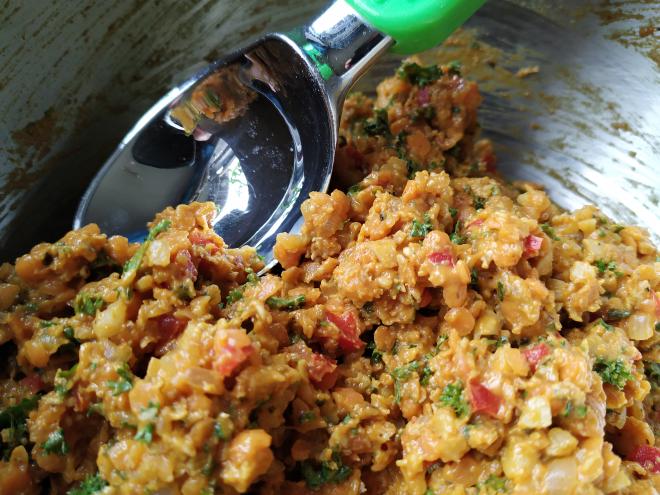
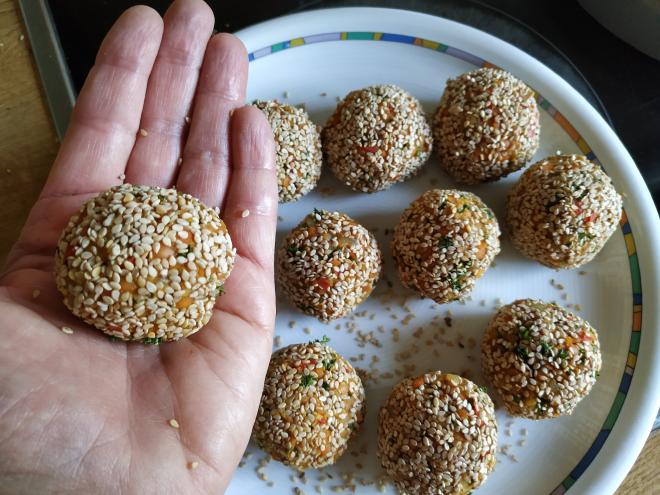
Recipe #
Curry lentil balls with salad
40 minutes
2 portions, makes about 10-15 balls
Ingredients #
Curry lentil balls
- 100 g red lentils
- 50 g oat flakes
- 1 clove of garlic
- 1/2 onion
- 1/2 red pointed bell pepper
- 1 tablespoons of oil
- 50 g chopped almonds
- 2 tablespoons tomato puree
- 1 tablespoon paprika powder
- 1 tablespoon curry powder
- 2 tablespoons soy sauce
- 1 teaspoon of salt
- 1 pinch of pepper
- 1 pinch of chilli powder
- 1 handful of parsley
- about 40g sesame seeds
- about 100 g oil for frying
Lentil and carrot salad
- 2 carrots
- 1/2 teaspoon salt
- 1/2 red pointed bell pepper
- 5 g parsley
- 2 tablespoons lemon juice
- 2 tablespoons olive oil
- 1 teaspoon maple syrup
- 1 pinch of pepper
Directions #
- Cook the red lentils in water until al dente, then drain. Put a third of the lentils aside for the salad. Purée the remaining lentils with a hand blender.
- Coarsely chop or crush the oats.
- Finely dice the garlic, onion and bell pepper and sauté in 1 tbsp of oil.
- Mix the puréed lentils, oats, garlic, onion and bell pepper with the chopped almonds, tomato purée, paprika powder, curry powder, soy sauce, salt, pepper, chilli powder and parsley. If the mixture is too dry, add a little more water. (The mixture should be moist but still easy to form into balls).
- Shape the mixture into about 10-15 balls, roll in sesame seeds and deep-fry in hot oil (alternatively, flatten the balls and fry in a pan).
- To make the lentil and carrot salad, peel the carrots and cut into long thin slices. Sprinkle with salt and knead lightly with your hands.
- Wash, seed and chop the second half of the red bell pepper. Wash, shake dry and chop the parsley.
- Make a dressing with the lemon juice, olive oil, maple syrup and pepper. Mix the salad ingredients well with the reserved third of the red lentils and the dressing.
- Arrange the salad on a platter and serve with the fried lentil curry balls.
Carbon Footprint #
In total, two portions of curry lentil balls with salad have an estimated carbon footprint of 1386 g.
This ranks it number 25 out of 57 recipes published on the blog so far in terms of estimated carbon footprint.
The estimated emissions are therefore still slightly better than the average of the recipes.Compared to the Red lentil balls with walnuts published here some time ago, the emissions of the curry lentil balls are slightly higher (+97 g CO2), but significantly lower compared to the reference recipes with meat (for example -2240 g CO2 compared to Spaghetti Bolognese, i.e. around 64% lower).
Among the individual ingredients, almonds and sesame stand out, both of which contribute significantly more than average to the greenhouse gas balance of this dish: together they account for around 12% of the weight of the ingredients, but around 38% of the estimated carbon footprint. The oil also makes an above-average contribution, although not to the same extent. On the other hand, the peppers, carrots and onions, for example, have very little impact on the climate.
| ingredient | carbon footprint per kg | carbon footprint (in g) for 2 servings | % of ingredients | % of CO2 emissions |
|---|---|---|---|---|
| Red lentils | 1.2 | 120 | 13% | 9% |
| Oat flakes | 0.6 | 30 | 7% | 2% |
| Garlic | 0.4 | 1 | 0% | 0% |
| Onion | 0.2 | 10 | 7% | 1% |
| pointed peppers | 0.6 | 98 | 22% | 7% |
| Oil | 3.2 | 32 | 1% | 2% |
| Chopped almonds | 5.8 | 288 | 7% | 21% |
| Tomato paste | 4.3 | 86 | 3% | 6% |
| Paprika powder | 1.1 | 8 | 1% | 1% |
| Curry powder | 1.1 | 8 | 1% | 1% |
| Soy sauce | 0.2 | 4 | 3% | 0% |
| Salt | 0.7 | 3 | 1% | 0% |
| Pepper | 1.1 | 1 | 0% | 0% |
| Chili powder | 1.1 | 1 | 0% | 0% |
| Parsley | 1.1 | 8 | 1% | 1% |
| Sesame | 6.1 | 242 | 5% | 17% |
| Oil | 3.2 | 320 | 13% | 23% |
| Carrots | 0.1 | 8 | 11% | 1% |
| Salt | 0.7 | 1 | 0% | 0% |
| Parsley | 1.1 | 6 | 1% | 0% |
| Lemon juice | 0.6 | 9 | 2% | 1% |
| Olive oil | 3.2 | 64 | 3% | 5% |
| Maple syrup | 0.7 | 3 | 1% | 0% |
| Pepper | 1.1 | 1 | 0% | 0% |
| Deep-fry balls | 33 | 2% |
